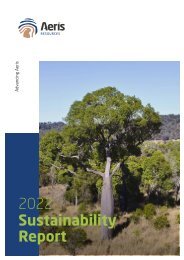Aeris Annual Report 2022
You also want an ePaper? Increase the reach of your titles
YUMPU automatically turns print PDFs into web optimized ePapers that Google loves.
<strong>Aeris</strong> Resources Limited<br />
Notes to the consolidated financial statements<br />
30 June <strong>2022</strong><br />
22. Financial instruments (continued)<br />
The significance and management of the risks to the consolidated entity are dependent on a number of factors including:<br />
● Interest rates (current and forward) and the currencies that the investments and borrowings are denominated in;<br />
● Level of cash, liquid investments and borrowings;<br />
● Maturity dates of investments and borrowings; and<br />
● Proportion of investments and borrowings that are fixed rate or floating rate.<br />
The risk is measured using market and cash flow forecasting.<br />
Sensitivity<br />
At 30 June <strong>2022</strong>, if interest rates had changed by -/+ 50 basis points from the weighted average year end rates with all<br />
other variables held constant, the consolidated entity's profit for the year would have been $0.428 million higher/lower<br />
(2021: loss would have been $0.289 million higher/lower), mainly as a result of higher/lower interest from loans, cash<br />
and cash equivalents and restricted cash.<br />
The exposure of the consolidated entity's interest bearing liabilities at balance sheet date to interest rate changes at the<br />
contractual re-pricing dates are as follows:<br />
<strong>2022</strong> 2021<br />
$'000 $'000<br />
0 - 12 months 6,214 6,140<br />
1 - 5 years 9,618 29,522<br />
15,832 35,662<br />
Credit risk<br />
Credit risk refers to the risk that a counterparty will default on its contractual obligations resulting in a financial loss to<br />
the consolidated entity. Credit risk is managed on a group basis. Credit risk arises from cash and cash equivalents,<br />
favourable derivative financial instruments and deposits with banks and financial institutions, as well as credit exposures<br />
to trade customers, including outstanding receivables and committed transactions.<br />
(i) Risk management<br />
Credit risk is managed on a consolidated basis. The maximum exposure to credit risk, excluding the value of any collateral<br />
or other security, at balance date to recognised financial assets, is the carrying amount, net of any provisions for<br />
impairment of those assets, as disclosed in the statement of financial position and notes to the financial statements.<br />
The consolidated entity has policies in place to ensure that sales of products are made to customers with an appropriate<br />
credit history and where necessary is effectively eliminated or substantially reduced by using bank and insurance<br />
instruments to secure payment for materials supplied and sold. The consolidated entity has policies that limit the amount<br />
of credit exposure to any one financial institution.<br />
(ii) Trade receivables<br />
The consolidated entity applies the AASB 9 Financial Instruments simplified approach to measuring expected credit losses<br />
which uses a lifetime expected loss allowance for all trade receivables. To measure the expected credit losses, trade<br />
receivables and contract assets have been grouped based on shared credit risk characteristics and the days past due.<br />
Payments from the consolidated entity’s two major customers are historically received within the contractual payment<br />
terms.<br />
31<br />
ADVANCING AERIS<br />
107





